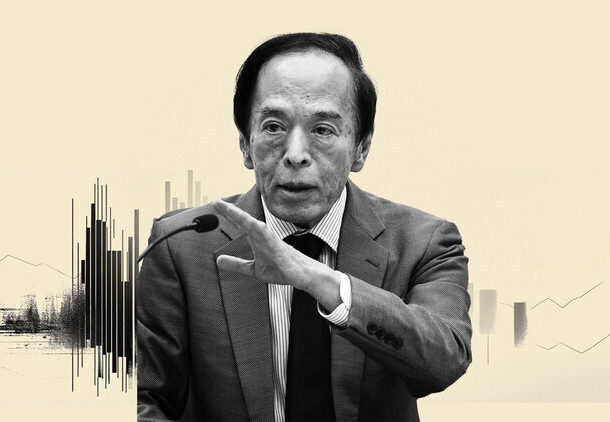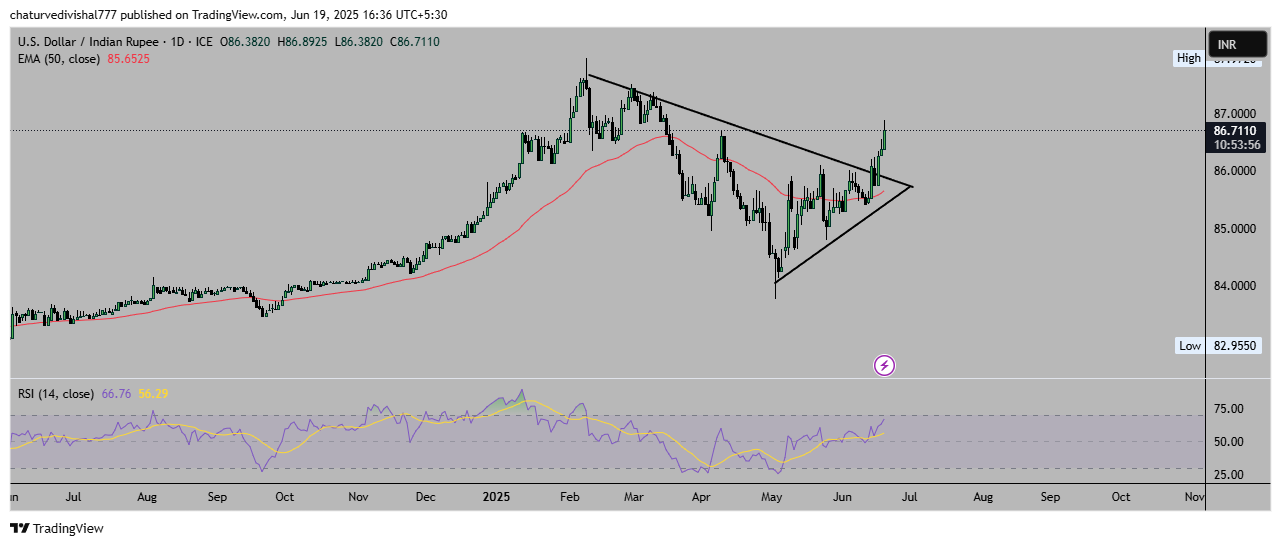
- Indian Rupee extends losing streak for the third consecutive day, hits weakest level since mid-March against the US Dollar.
- Israel–Iran conflict enters seventh day, US reportedly prepared for possible military strike.
- Brent and WTI crude are up over 20% this month, supply fears keep prices elevated.
The Indian Rupee (INR) extends its losing streak for a third consecutive day against the US Dollar (USD) on Wednesday, sliding to a three-month low as the escalating Middle East conflict fuels fresh supply worries and keeps Crude Oil prices elevated. Higher Oil costs continue to strain India’s import bill, adding persistent pressure on the Rupee.
The USD/INR pair is trading flat near ₹86.70 during the American trading hours, as holiday-thinned liquidity keeps price action subdued. The pair remains slightly below its intraday peak of ₹86.89 touched earlier in the European session. Meanwhile, the US Dollar Index (DXY), which measures the Greenback’s strength against a basket of six major currencies, holds steady around 98.89 after the Federal Reserve (Fed) left interest rates unchanged on Wednesday, reinforcing broad Dollar resilience amid an already uncertain global outlook. With US financial markets closed on Thursday for the Juneteenth holiday, trading volumes are light and fresh momentum is likely to return once liquidity picks up on Friday.
As the Iran–Israel conflict enters its seventh day, both nations have continued heavy strikes — Israel targeting Iran’s nuclear and military installations, and Iran responding with waves of ballistic missiles and drones toward Israeli territory, including civilian hospitals. The US has reinforced its regional posture by deploying additional naval vessels and aircraft assets to serve as a deterrent amid rising tensions. US President Donald Trump has publicly backed Israel’s campaign, praising its strikes as “excellent” and warning Iran of “even more brutal” action if it fails to capitulate on its nuclear ambitions. Trump remains non-committal about direct US military involvement, saying, “I may do it. I may not do it. I mean, nobody knows what I’m going to do.”
Market Movers: INR at three-month low, Oil surges on supply fears, Fed holds rates
- The Indian Rupee falls to its lowest level since mid-March against the US Dollar on Thursday as heightened risk aversion gripped financial markets, with traders bracing for the possibility of direct US involvement in the Israel–Iran conflict.
- Fresh reports intensified market jitters late Wednesday, with The Wall Street Journal revealing that US President Donald Trump had given private approval for potential military action against Iran but paused the final directive to gauge Tehran’s willingness to halt its nuclear efforts. In parallel, Bloomberg reported that US defense officials are actively preparing for a possible strike on Iranian targets in the near term. This rising threat of broader conflict has boosted Crude Oil prices.
- In an exclusive interview with NDTV, India’s Petroleum and Natural Gas Minister Hardeep Singh Puri reassured markets that the country has enough oil reserves to manage any near-term disruptions stemming from the Iran–Israel conflict. “We are constantly monitoring the situation. No reason to worry about energy count. India has sufficient energy reserves to last for weeks,” Puri said, adding that authorities remain vigilant as crude prices surge on supply concerns.
- Speculation over a potential Iranian blockade of the strategic Strait of Hormuz has intensified after a former Iranian minister suggested oil and LNG shipments should pass only with Tehran’s approval. India’s Petroleum Minister Hardeep Singh Puri sought to allay concerns, stating that only a small share of India’s oil imports—about 1.2 million barrels per day—actually transit the Strait, while the bulk comes from Russia and other sources. Puri added that India has contingency plans to boost domestic production, curb exports if needed, and diversify purchases to manage any supply shock
- The Iran–Israel conflict has driven a sharp rally in Oil prices, with Brent crude futures last trading near $76 per barrel, marking a gain of over 20% so far this month. West Texas Intermediate (WTI) is holding around $74 at the time of writing, up roughly 22% month-to-date. Escalating hostilities and fears of potential US involvement have stoked fresh supply concerns, keeping both benchmarks well bid despite subdued holiday trading in the US.
- Oil makes up a significant portion of India’s total imports, and economists estimate that every $10 per barrel rise in crude prices can expand the country’s current account deficit by as much as 0.4% of GDP.
- The deepening Middle East conflict threatens key Indian trade corridors. Payments for basmati rice exports to Iran, worth more than ₹6,374 crore in FY25, are seeing delays of over 180 days. New security checks cloud India’s robust $10.1 billion trade with Israel. Meanwhile, India’s strategic bet on Iran’s Chabahar Port, with $85 million invested to tap Central Asian routes, hangs in the balance as the port’s security outlook turns fragile.
- The Fed kept its benchmark interest rate unchanged at the 4.25%–4.50% range on Wednesday, sticking to a cautious approach as officials balance moderate economic growth with persistent inflation risks. Policymakers hinted at the possibility of two rate cuts before the end of the year but stressed that any adjustment would depend on how inflation and broader economic data evolve in the coming months.
- Fed Chair Jerome Powell emphasised caution on Wednesday, warning that the Fed’s economic projections are far from ironclad. Powell urged markets not to over-rely on the “dot-plot,” noting that all future rate decisions will remain data-dependent. He framed the messaging as “no one holds these rate paths with a great deal of conviction,” underlining the central bank’s adaptive stance.
USD/INR Technical Outlook: Strong triangle breakout fuels bullish momentum

The USD/INR pair has staged a strong breakout from a multi-month symmetrical triangle pattern on the daily chart, printing consecutive bullish candles that signal renewed upward momentum. Price action remains comfortably above the breakout zone, with the 50-day Exponential Moving Average (EMA) near 85.65 now acting as dynamic support if any profit-taking emerges.
The daily Relative Strength Index (RSI) is holding around 66, indicating healthy bullish momentum with room to test overbought levels before any pullback. If the pair maintains this bullish structure, a clear push above the 87.00 round number could pave the way toward the next resistance at 87.50–88.00. On the downside, dips back toward 86.00–86.20 may attract fresh buying interest, keeping the broader uptrend intact.
Indian economy FAQs
The Indian economy has averaged a growth rate of 6.13% between 2006 and 2023, which makes it one of the fastest growing in the world. India’s high growth has attracted a lot of foreign investment. This includes Foreign Direct Investment (FDI) into physical projects and Foreign Indirect Investment (FII) by foreign funds into Indian financial markets. The greater the level of investment, the higher the demand for the Rupee (INR). Fluctuations in Dollar-demand from Indian importers also impact INR.
India has to import a great deal of its Oil and gasoline so the price of Oil can have a direct impact on the Rupee. Oil is mostly traded in US Dollars (USD) on international markets so if the price of Oil rises, aggregate demand for USD increases and Indian importers have to sell more Rupees to meet that demand, which is depreciative for the Rupee.
Inflation has a complex effect on the Rupee. Ultimately it indicates an increase in money supply which reduces the Rupee’s overall value. Yet if it rises above the Reserve Bank of India’s (RBI) 4% target, the RBI will raise interest rates to bring it down by reducing credit. Higher interest rates, especially real rates (the difference between interest rates and inflation) strengthen the Rupee. They make India a more profitable place for international investors to park their money. A fall in inflation can be supportive of the Rupee. At the same time lower interest rates can have a depreciatory effect on the Rupee.
India has run a trade deficit for most of its recent history, indicating its imports outweigh its exports. Since the majority of international trade takes place in US Dollars, there are times – due to seasonal demand or order glut – where the high volume of imports leads to significant US Dollar- demand. During these periods the Rupee can weaken as it is heavily sold to meet the demand for Dollars. When markets experience increased volatility, the demand for US Dollars can also shoot up with a similarly negative effect on the Rupee.
Information on these pages contains forward-looking statements that involve risks and uncertainties. Markets and instruments profiled on this page are for informational purposes only and should not in any way come across as a recommendation to buy or sell in these assets. You should do your own thorough research before making any investment decisions. FXStreet does not in any way guarantee that this information is free from mistakes, errors, or material misstatements. It also does not guarantee that this information is of a timely nature. Investing in Open Markets involves a great deal of risk, including the loss of all or a portion of your investment, as well as emotional distress. All risks, losses and costs associated with investing, including total loss of principal, are your responsibility. The views and opinions expressed in this article are those of the authors and do not necessarily reflect the official policy or position of FXStreet nor its advertisers. The author will not be held responsible for information that is found at the end of links posted on this page.
If not otherwise explicitly mentioned in the body of the article, at the time of writing, the author has no position in any stock mentioned in this article and no business relationship with any company mentioned. The author has not received compensation for writing this article, other than from FXStreet.
FXStreet and the author do not provide personalized recommendations. The author makes no representations as to the accuracy, completeness, or suitability of this information. FXStreet and the author will not be liable for any errors, omissions or any losses, injuries or damages arising from this information and its display or use. Errors and omissions excepted.
The author and FXStreet are not registered investment advisors and nothing in this article is intended to be investment advice.








